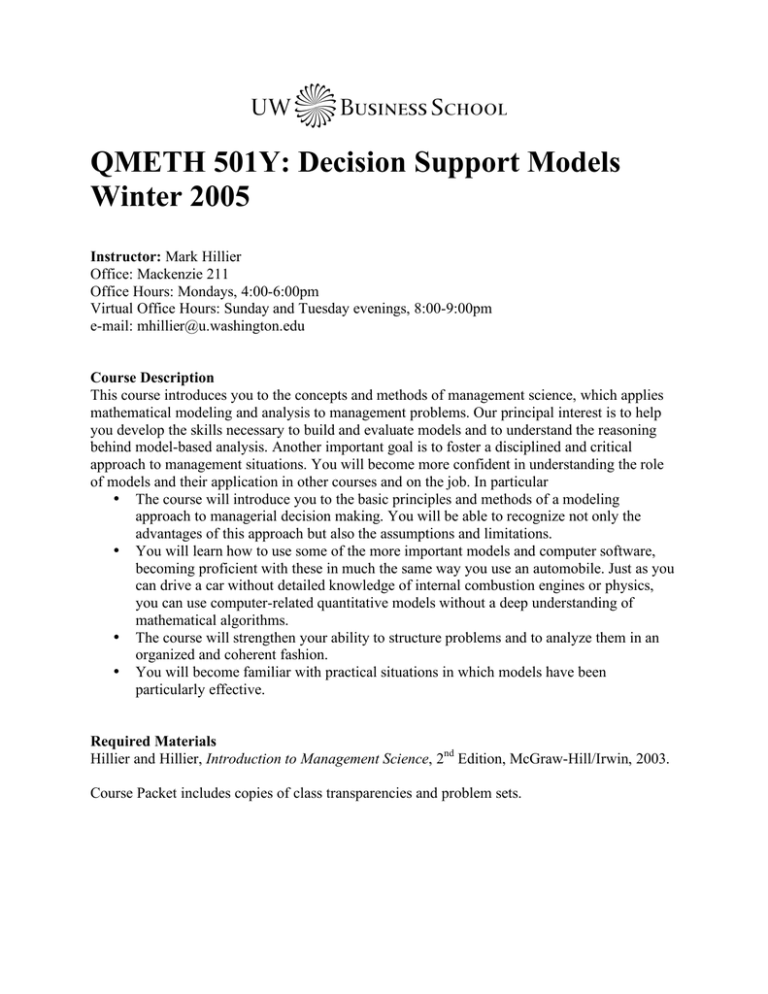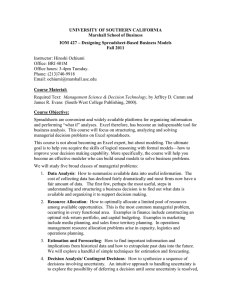QMETH 501Y: Decision Support Models Winter 2005
advertisement

QMETH 501Y: Decision Support Models Winter 2005 Instructor: Mark Hillier Office: Mackenzie 211 Office Hours: Mondays, 4:00-6:00pm Virtual Office Hours: Sunday and Tuesday evenings, 8:00-9:00pm e-mail: mhillier@u.washington.edu Course Description This course introduces you to the concepts and methods of management science, which applies mathematical modeling and analysis to management problems. Our principal interest is to help you develop the skills necessary to build and evaluate models and to understand the reasoning behind model-based analysis. Another important goal is to foster a disciplined and critical approach to management situations. You will become more confident in understanding the role of models and their application in other courses and on the job. In particular • The course will introduce you to the basic principles and methods of a modeling approach to managerial decision making. You will be able to recognize not only the advantages of this approach but also the assumptions and limitations. • You will learn how to use some of the more important models and computer software, becoming proficient with these in much the same way you use an automobile. Just as you can drive a car without detailed knowledge of internal combustion engines or physics, you can use computer-related quantitative models without a deep understanding of mathematical algorithms. • The course will strengthen your ability to structure problems and to analyze them in an organized and coherent fashion. • You will become familiar with practical situations in which models have been particularly effective. Required Materials Hillier and Hillier, Introduction to Management Science, 2nd Edition, McGraw-Hill/Irwin, 2003. Course Packet includes copies of class transparencies and problem sets. QMETH 501Y Syllabus Decision Support Models Page 2 Course Packet I have prepared extensive course notes that I use as overheads during lecture. These course notes include examples that we will work together in class and other lecture material. The course notes are not intended as material that you use to prepare for class; my intent is for them to make it easier for you to listen, ask questions, and participate in class, rather than take lots of your own notes during the lectures. Software Microsoft Excel (including Solver), Solver Table (available on Blackboard), TreePlan (available on the textbook CD) and Crystal Ball (old version available on the textbook CD, new version will be available for download). Grading Policy The course grade will be based on problem sets and a final exam. The final grade will be based on the following weights: Problem Sets: Final Exam: 25% 75% Problem Sets Three graded problem sets will be assigned in order to provide you the opportunity to develop and apply the concepts and tools discussed in class. Students should work in their pre-assigned study groups. Each group should submit only one problem set for grading with the names of all members prominently displayed on the first tab of the spreadsheet. All group members will receive the same grade for each problem set submitted. Please note that spreadsheet modeling is best learned by doing. Therefore, it is critical that each student try to setup and solve each of the problems in the problem sets on their own before using the group interaction to clarify and streamline the various analyses. Each group should turn in their solution via Blackboard no later than the start of class on the day it is due. Please title the file by your group name and the problem set number (e.g., G6PS1). If possible, include all spreadsheets in a single workbook on separate tabs. Exam The final exam will be in two parts -- in-class and take-home. The in-class portion will be closed book, closed notes, with one single-sided, letter-sized page of notes allowed. The take-home portion will be open book, open notes, but must be completed individually, without assistance from any other person. Topics • Linear Programming • Sensitivity Analysis • Integer Programming • Decision Analysis • Simulation with Crystal Ball QMETH 501Y Syllabus Decision Support Models Page 3 Schedule Monday, February 7: Session #1 Skim: Text, Chapter 1 Session #1: Modeling with Spreadsheets. In this session we will discuss the role of models in managerial decision making, including the use of spreadsheets, and provide an overview of the models and techniques to be covered in this quarter. We will then "jump right in" and develop a spreadsheet model that addresses a managerial decision to be made. Wednesday, February 9: Session #2 Read: Text, Chapter 2 Introduction to Linear Programming. Through a hands-on example (using Lego building blocks), we introduce the linear programming model. We will then discuss the use of the Solver feature in Microsoft Excel for modeling and solving such problems. We discuss the benefits and pitfalls of modeling a problem as a linear model. Finally, we examine the process of solving linear programs and basic properties of their solutions. Monday, February 14: Session #3 Read: Text, Chapters 3 and 4 DUE: PROBLEM SET #1 Formulation of Linear Programming Models In this session we learn to recognize the various kinds of managerial problems to which linear programming can be applied. We will formulate linear programs that address problems from a variety of different business areas Wednesday, February 16: Session #4 Read: Text, Chapter 5 Sensitivity Analysis We discuss the use of Solver output for performing post-optimality or sensitivity analysis for linear programs. This analysis is useful in testing the robustness of the solutions to a particular model, and also in providing valuable economic information about the problem being analyzed. QMETH 501Y Syllabus Decision Support Models Page 4 Wednesday, February 23: Session #5 Read: Text, Chapter 9 DUE: PROBLEM SET #2 Integer Programming In this session we address problems where some or all of the decision variables are required to assume integer values. We discuss when rounding is appropriate and when it is not. We also discuss the application of binary variables to making "yes-or-no" type decisions. Monday, February 28: Session #6 Read: Text, Sections 12.1-12.3 Introduction to Decision Analysis We discuss an approach to making decisions when there is uncertainty or risk present. We will discuss different criteria for making decisions and introduce decision trees as a tool for framing these problems. The TreePlan Excel add-in for developing decision trees is demonstrated. Wednesday, March 2: Session #7 Read: Text, Sections 12.4-12.11 Sequential Decisions, The Value of Information, Risk Attitude, and Utility Functions Here we will discuss methods for adapting decision trees to evaluate the value of information that might be gathered before a decision needs to be made. Then we introduce the concept of risk aversion and discuss the importance of incorporating risk attitudes in a decision analysis model. We will discuss the use of utility functions to model risk aversion. QMETH 501Y Syllabus Decision Support Models Page 5 Monday, March 7: Session #8 Skim: Text, Chapter 15 Read: Text, Chapter 16 DUE: PROBLEM SET #3 Simulation and Crystal Ball In this session we discuss and demonstrate the role of simulation as a tool for analyzing systems involving uncertainty or risk. We discuss the use of the Crystal Ball Excel add-in for performing Monte-Carlo simulation. Wednesday, March 9: Session #9 Applications of Simulation In this session we continue discussion of Monte-Carlo simulation and the Crystal Ball Excel addin and its application to various business problems. Monday, March 14: In-Class Final Exam Anytime between March 9 and March 19 (but please refrain from any group interaction after March 14): RECOMMENDED: PROBLEM SET #4 (SELF-GRADED) Saturday, March 19 (midnight): DUE: Take-Home portion of Final Exam (done individually)






